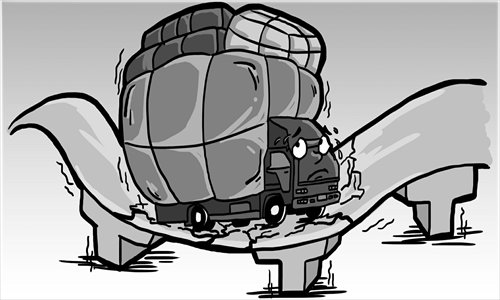Power of markets can lift weight off strained roads and bridges

A road bridge in the city of Harbin, Heilongjiang Province collapsed on August 24, promoting the public to question what might have triggered the incident. Although the local government has conducted a preliminary investigation and claimed the cause of the incident was overloaded trucks, the media and the public still suspect that the bridge was poorly constructed.
The public has the right to question the authorities. Many of their speculations regarding the incident are understandable. But to understand the collapse of the bridge does require certain professional knowledge, without which any judgment of the incident will not be reliable.
The theory that the collapse was caused by overloaded trucks makes sense from the information announced by the government and reported by some prudent media. The four trucks found at the incident site have a combined weight of over 400 tons, but the standard weight limit of each truck was no more than 20 tons.
In China, it is quite common to see trucks with a weight limit of 20 tons being modified to carry goods weighing more than 200 tons. Conventional wisdom often attributes the overloading issue to expensive highway toll. People argue that if transportation service providers don't overload their trucks, they won't be able to earn any profit.
But overloading is in fact a type of subsidy transportation service providers get from society. They can still profit if they run their services legally.
But if fines for overloading are cheaper than the costs they would pay for running their service legally, then transportation service providers, driven by profit and heated competition, will choose overloading.
Doing so will save them highway tolls as well as fuel and labor costs, but it will also severely damage infrastructure like roads and bridges, which are paid for by taxpayers.
However, transportation service providers will not receive much benefit from this subsidy because the whole industry is overloading their trucks. And so the costs they "save," combined with fierce competition, will ultimately press down prices.
Transportation service providers will thus earn no more than what they would gain if they ran their service legally. This will eventually force transportation service providers to further overload their trucks, creating a vicious circle.
If the authorities can raise the penalty to a level higher than the cost transportation service providers would pay if they ran their service legally, it will effectively eliminate this issue. Currently, the problem is that infrastructure repairing and fining trucks are handled by two different departments.
The traffic authorities, which are in charge of checking and fining overloaded trucks, are allowed to keep the penalty money as their revenue, so that the authorities, instead of striving to eliminate the issue, will often allow truck drivers to carry out their work after they pay their fines.
The government is also concerned about pushing up commodity prices if it uses tougher measures to crack down on overloaded trucks. But who will shoulder this cost is primarily decided by who has less flexibility in the relationship of demand and supply.
Currently, most overloaded trucks are filled with construction materials like coals, ore and sand. The supply of these materials is limited, so that if transportation fee is to go up, buyers of these materials will have to cope with the pain.
But as for other commodities, since the source of supply is abundant and alternatives can be easily found, buyers of these goods won't feel much if the transportation fee rises.
The author is CCTV commentator. opinion@globaltimes.com.cn
Experts' View
Zou Enjie, an expert on road and bridge construction based in Beijing
Many people were wondering why bridges constructed in the modern day are not as solid as bridges like Zhaozhou Bridge or the Lugou Bridge that were built a few centuries ago.
These ancient bridges indeed reflect the wisdom of our ancestors, but it is not scientific to draw a simple comparison between them and bridges built in the modern day.
In fact, these bridges have undergone many revamps to make sure they survive in the present day and none of them take any vehicles. They can no longer bear the traffic flow required in this era.
Guo He, an expert on road and bridge construction based in Beijing
It is often ignored that our bridges' capacity is stretched to extremes in order to support the rapid development of our economy. Overloading is one of the most common issues affecting our road safety today. Constantly enduring such extreme pressure will certainty reduce the tolerance of bridges.
And it is worrying that many trucks are still allowed to run on roads and bridges that are not designed to tolerate this much weight.
We haven't yet conducted comprehensive research on overloading and especially on how to effectively cope with serious cases.
My suggestion is to introduce the formula on bridges' tolerance already applied in some developed countries into designing our bridges.